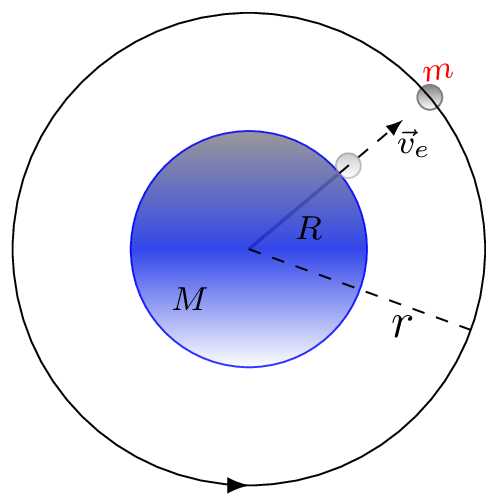Subsection 6.1.4 Escape Velocity

The minimum velocity of an object with which it can be thrown out from the planet so that it never come back is known as escape velocity. Suppose a stone of mass \(m\) is thrown out from a planet with a velocity \(v_{e}\) so that it never fall back on the earth again, then the total energy of the stone on the planet, \(E_{p}\) is equal to total energy of the stone at infinity, \(E_{\infty}. \)
\begin{equation*}
E_{p} = E_{\infty} \quad \Rightarrow\quad KE_{p} + PE_{p} =KE_{\infty}+PE_{\infty}
\end{equation*}
\begin{equation*}
\frac{mv^{2}_{e}}{2}-\frac{GMm}{R} = 0-\frac{GMm}{\infty}
\end{equation*}
\begin{equation*}
\therefore v_{e} = \sqrt{\frac{2GM}{R}}
\end{equation*}
Where \(r=R+h\text{,}\) \(m\text{,}\) and \(M\) are distance of a satellite (object), mass of a satellite, and mass of the planet, respectively. Here \(R\) is radius of the planet, \(G\) is universal gravitational constant, and \(h\) is the altitude of the satellite from the surface of the planet. If radius of the earth, \(R=6.37\times10^{6}m\) and mass of the earth is \(M=5.97\times10^{24}kg\text{,}\) then
\begin{equation*}
v_{e} = \sqrt{\frac{2\times 6.67\times10^{-11}\times5.97\times10^{24}}{6.37\times10^{6}}}
\end{equation*}
\begin{equation*}
\therefore \quad v_{e} =1.12\times10^{4}m/s= 11.2km/s.
\end{equation*}
